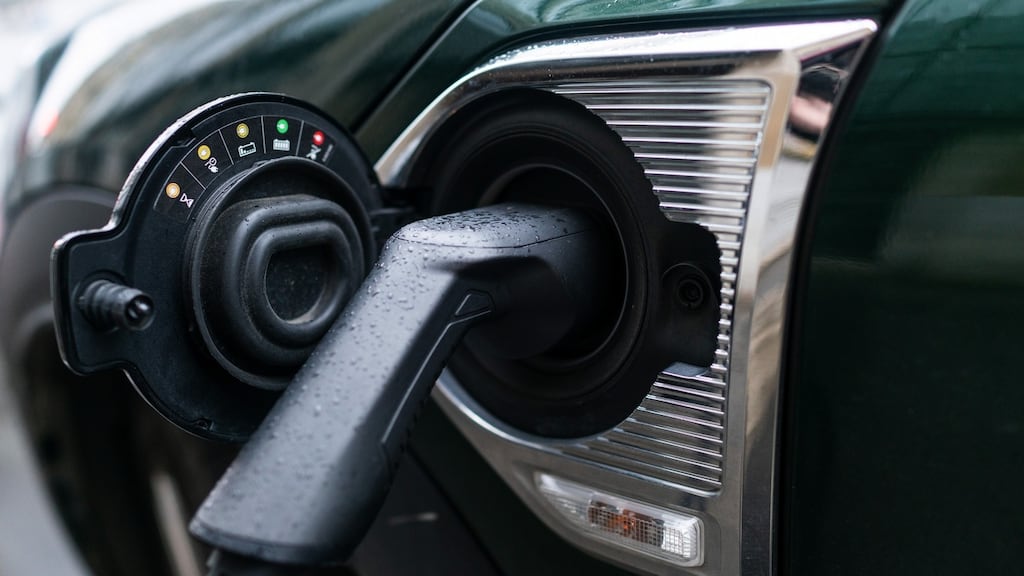While sales of both full-electric cars and what might be called “old-fashioned” hybrids have continued to rise in Ireland in 2022, sales of plug-in hybrids have started to slip. Indeed, with electric sales climbing so far this year by 70 per cent, in spite of shortages in supply the market for PHEVs has fallen by 6.4 per cent so far.
Some of this can be ascribed to production shortages – PHEVs use more computer chips and more complex electronics than their conventional petrol or diesel stablemates, and so they have been especially hard-hit by the continuing bottlenecks in computer chip manufacture. Don’t electric cars need the same chips? Yes, they do but many car companies have been prioritising chip supply for EVs, needing to hit electric car sales targets to avoid costly emissions fines.
PHEVs – Plug-in Hybrid Electric Vehicles to give them their full name – have at times seemed like the ideal part-electric solution for many car buyers. The idea is that you get a big enough battery for some all-electric range, usually around 50-60km when you charge up fully from the mains, but you still have a petrol engine and a fuel tank on board to make longer journeys painless. Given the continued paucity of the national public charging network, a PHEV seemed like a sensible choice.
Especially so when you looked at their on-paper emissions. Most PHEV models are rated at less than 50g/km of CO2 emissions. Some even dip below 20g/km, and all of them have wildly impressive fuel economy figures – some knocking on the door of 300mpg, or 1.0-litres per 100km.
The problem is that those figures are indeed wildly overestimated. Even the official WLTP emissions and economy test, so much tougher than the old, discredited NEDC test, seems to give PHEVs a tough time of it, overestimating their electric-only range and over-cooking their economy claims.
In the real world, things are very different. Those 50-60km ranges can often dip to under 30km if you dare take your PHEV on a motorway, or use its air conditioning system. And when you do undertake a longer journey, you can forget about 1.0-litres per 100km. However, 6.5-litres per 100km is more like the average you will get, with some models heading north of 8.0-litres per 100km.
The EU has had enough of this, and has decided that from 2025 it will start measuring the emissions and consumption of a PHEV more realistically. By 2027, it is expected that “the utility factors of plug-in hybrids will be fully aligned with how they are driven in the real world”.
One major cheerleader for this move has been the environmental think-tank Transport & Environment, which has previously decried PHEVs, calling them “fake electric cars” and accusing car makers of blatantly using them to sidestep stricter emissions regulations.
Anna Krajinska, emissions engineer at T&E, told The Irish Times: “For years, the emissions of plug-in hybrids were based on unrealistic driving conditions. The new rules reflect the reality that PHEVs pollute far more than carmakers claim. Governments which still incentivise the purchase of these fake electric vehicles need to stop those harmful subsidies now.”
According to T&E, PHEVs on average use three times as much fuel as they do on official tests, meaning that their emissions are three times higher too. In general, it is drivers who are blamed for this disparity – many claim that owners tend to forget or ignore regular charging and spend more time driving on the petrol engine than the PHEV was designed for. T&E says that claim is rubbish – the real issue is that: “PHEVs are poorly made with small batteries, weak electric motors, big engines, and usually no ability to fast charge.”
From 2025 onwards, EU legislation will reflect data taken from real-world tests of PHEVs, and on on data collected from on-board fuel consumption meters, which will give a more comprehensive assessment of the share of kilometres driven electrically.
Anna Krajinska said: “We welcome the end of the myth that plug-in hybrids are low emissions vehicles. Carmakers will no longer be able to sell high volumes of PHEVs for the sole purpose of weakening their climate targets. If they want to avoid EU fines they will have to sell genuinely green cars that help reduce our oil consumption.”
Is this an effective ban on PHEVs? And is that a good thing? Some are not so sure.
VW Group chief executive Herbert Diess said in a recent interview: “Plug-in hybrids are justified and are wrongly criticised so strongly. If you drive the new VW Tiguan PHEV, it can do 60km on electric power. Many Tiguan customers drive 80 per cent of their total driving distance with it. Modern plug-in hybrids are a good choice both economically and ecologically. The CO2 balance is nowhere near as negative as is occasionally shown.”
Others take a more nuanced approach. “People want independent, transparent information about the environmental impact of cars. These PHEV results show why that is so important,” said GreenNCAP’s Niels Jacobsen.
“Consumers could be forgiven for thinking that, by buying a car labelled ‘PHEV’ and keeping it charged all the time, they will be doing their bit for the environment, but these results show that this is not necessarily the case.
“The Mitsubishi Outlander shows that a big, heavy vehicle with a limited driving range is unlikely to offer any benefit over a conventional car. On the other hand, Toyota, with its long experience of hybrid technology, has done a terrific job and the Prius, properly used, can offer clean, efficient transport.
“It depends on the implementation and hybridisation strategy but what is true of all PHEVs is that they need to be charged regularly and driven as much as possible on battery power if they are to fulfil their potential.”
BMW points out that some of its PHEV models have one-charge electric ranges of as much as 88km, and that: “plug-in hybrid models are perfectly suited to urban and city driving by completing most commutes with pure-electric power.
“The significant contribution plug-in hybrid vehicles can make to reducing tailpipe emissions in cities was demonstrated in an early trial of this technology, carried out in the Netherlands in 2018. Results of this research project showed 90 per cent of all routes within the trial zone in Rotterdam were driven in electric-only mode.
“As BMW anchors sustainability in the heart of its corporate strategy, there is a goal to avoid the emissions of over 200-million tonnes of CO2 by 2030. This is equivalent to more than 20 times the annual CO2 emissions of a city with over a million inhabitants, like Munich. To achieve this, the BMW Group is reducing its vehicles’ carbon footprint throughout their lifecycle – from raw material extraction, through production and the use phase, to end-of-life recycling.”
However, a report by the Miles Consultancy and the BBC found that in 2020, the majority of plugin-hybrid cars bought were not being plugged in and charged up regularly, or in some cases at all. Driving a plugin-hybrid without charging it from the mains causes the fuel consumption to plummet, in some cases to well below the 9.0-litres per 100km mark, in cars which often claim overall fuel economy as high as 2.0-litre per 100km.
Many buyers, including corporate fleets, were accused of buying plugin-hybrids simply for the tax advantages and the government grant which reduced the purchase price, but never intended to use the zero-emissions electric range of the vehicles.



















